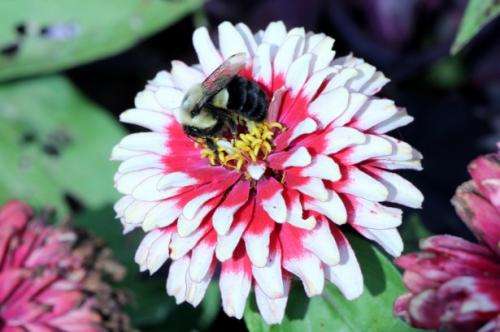Credit: Lilla Frerichs/public domain
(Phys.org)—A team of researchers with the University of Milan has found that there exists a mutualistic symbiotic relationship between parasitic mites and the pathogenic virus that is believed to be responsible for widespread honeybee colony loss. In their paper published in Proceedings of the National Academy of Sciences, the team describes a three-pronged approach they used in studying the relationship between the mite (Varroa destructor), honey bees and the deformed wing virus which is believed to be responsible for widespread honeybee colony loss.
Scientists have been hard at work trying to understand what has caused huge numbers of honeybees to be lost as their colonies collapse—the latest research suggests it is due to the deformed wing virus parasitizing the honeybees, attacking their larvae where they reproduce . The damage caused to honeybees and their colonies has been well documented, in this new effort, the researcher wanted to know if the mites were simple carriers, or if they benefited from carrying the virus to a bee larva. To find out, the team carried out a three-pronged study.
The first part of the study involved testing the immune response of infected bees, which they believed would offer a gauge of how receptive they were to mites parasitizing them. They implanted tiny threads in their bodies to see how well the bee did in encapsulating them, the main method used by the bees to stop infection threats. The team found that the infected bees were less effective doing so than non-infected bees.
The second part of the study involved carrying out a genetic analysis to determine the degree of expression levels of genes involved in the immune process—this too showed that infected bees had a less effective immune system.
The third part of the study involved comparing the number of offspring for mites involved in infecting bees, versus mites that were not infecting bees—here the team found that mites infecting bees produced more offspring.
Taken together, the researchers suggest that mites were at least partly responsible for a weakened immune system which allowed them to produce more than normal numbers of offspring in bee larvae, which indicates a mutualistic symbiotic relationship exists between the mites and the virus, benefiting them both while adversely impacting honeybees.
More information: Gennaro Di Prisco et al. A mutualistic symbiosis between a parasitic mite and a pathogenic virus undermines honey bee immunity and health, Proceedings of the National Academy of Sciences (2016). DOI: 10.1073/pnas.1523515113
Abstract
Honey bee colony losses are triggered by interacting stress factors consistently associated with high loads of parasites and/or pathogens. A wealth of biotic and abiotic stressors are involved in the induction of this complex multifactorial syndrome, with the parasitic mite Varroa destructor and the associated deformed wing virus (DWV) apparently playing key roles. The mechanistic basis underpinning this association and the evolutionary implications remain largely obscure. Here we narrow this research gap by demonstrating that DWV, vectored by the Varroa mite, adversely affects humoral and cellular immune responses by interfering with NF-κB signaling. This immunosuppressive effect of the viral pathogen enhances reproduction of the parasitic mite. Our experimental data uncover an unrecognized mutualistic symbiosis between Varroa and DWV, which perpetuates a loop of reciprocal stimulation with escalating negative effects on honey bee immunity and health. These results largely account for the remarkable importance of this mite–virus interaction in the induction of honey bee colony losses. The discovery of this mutualistic association and the elucidation of the underlying regulatory mechanisms sets the stage for a more insightful analysis of how synergistic stress factors contribute to colony collapse, and for the development of new strategies to alleviate this problem.
Journal information: Proceedings of the National Academy of Sciences
© 2016 Phys.org






















